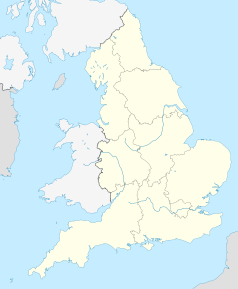Somerleyton, Ashby and Herringfleet
(c) Evelyn Simak, CC BY-SA 2.0 Somerleyton Hall | |
| Państwo | |
|---|---|
| Kraj | |
| Hrabstwo | |
| Dystrykt | |
| Populacja (2011) • liczba ludności |
|
Położenie na mapie Suffolk Contains Ordnance Survey data © Crown copyright and database right, CC BY-SA 3.0 | |
Położenie na mapie Wielkiej Brytanii (c) Karte: NordNordWest, Lizenz: Creative Commons by-sa-3.0 de | |
| 52,526°N 1,664°E/52,526000 1,664000 | |
| Portal | |
Somerleyton, Ashby and Herringfleet – civil parish w Anglii, w Suffolk, w dystrykcie Waveney. W 2011 civil parish liczyła 427 mieszkańców[1].
Przypisy
- ↑ Neighbourhood Statistics. [dostęp 2015-03-06]. [zarchiwizowane z tego adresu (2015-04-02)].
Linki zewnętrzne
- One Suffolk. somerleyton.onesuffolk.net. [zarchiwizowane z tego adresu (2015-04-02)].
Media użyte na tej stronie
(c) Karte: NordNordWest, Lizenz: Creative Commons by-sa-3.0 de
Location map of the United Kingdom
Flag of England. Saint George's cross (a red cross on a white background), used as the Flag of England, the Italian city of Genoa and various other places.
Contains Ordnance Survey data © Crown copyright and database right, CC BY-SA 3.0
Map of Suffolk, UK with the following information shown:
- Administrative borders
- Coastline, lakes and rivers
- Roads and railways
- Urban areas
Equirectangular map projection on WGS 84 datum, with N/S stretched 160%
Geographic limits:
- West: 0.30E
- East: 1.90E
- North: 52.57N
- South: 51.92N
(c) Evelyn Simak, CC BY-SA 2.0
Somerleyton Hall. The first stone manor house on the site was built in about 1240 by Sir Peter Fitzosbert. He was succeeded by the Jernegan family who lived at Somerleyton for 13 generations. The tomb chest of Sir Richard Jernegan > 1505740 - Privy Councellor to Henry VIII - is the oldest feature in St Mary's church > 1505719 which is located in the grounds, a short distance to the south. In 1610 the house was rebuilt in the East Anglian Tudor-Jacobean style by John Wentworth, also commemorated in St Mary's church > 1505744. Sir John was captured and jailed during the English Civil War (but later freed by Cromwell's troops) and one of his captors, Sir Thomas Allin, bought the estate in 1672. Sir Morton Peto acquired the estate in 1843 and had it changed to the Italian-Victorian house we see today. Sir Peto also had St Mary's church repaired and refurbished. A new model village > 1505643 was built to the design of John Thomas, the architect of Somerleyton Hall, and the railway > 1505968 was brought to the village in 1847. Sir Francis Crossley bought the Hall from Peto in 1863. In 1916 Sir Savile Crossley became Baron Somerleyton and his son, the 3rd Baron, inherited the title in 1959. Charles Dickens - a friend of Morton Peto - visited in 1848 while researching and writing 'David Copperfield' which is set in nearby Blundeston. Sir Christopher Cockerell, inventor of the Hovercraft, tested his first model on the Pergola Lawn of the Hall.









